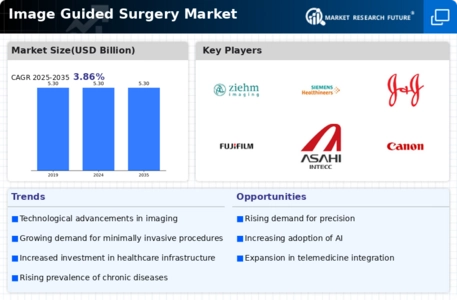Rising Incidence of Chronic Diseases
The prevalence of chronic diseases such as cancer, cardiovascular disorders, and neurological conditions is on the rise, significantly impacting the Image Guided Surgery Market. As these diseases often require complex surgical interventions, the demand for image-guided surgical procedures is expected to increase. Data indicates that the number of surgical procedures performed annually is projected to reach over 20 million by 2026, with a substantial portion being image-guided. This trend underscores the necessity for advanced surgical techniques that can enhance the effectiveness of treatment while minimizing risks associated with traditional surgery.
Growing Focus on Patient Safety and Outcomes
In the Image Guided Surgery Market, there is an increasing emphasis on patient safety and surgical outcomes. Healthcare providers are prioritizing technologies that reduce complications and improve recovery times. Image-guided surgery offers enhanced precision, which is crucial in minimizing surgical errors. Recent studies suggest that the adoption of image-guided techniques can lead to a reduction in post-operative complications by up to 30%. This focus on safety not only improves patient satisfaction but also aligns with regulatory requirements aimed at enhancing healthcare quality, thereby driving market growth.
Technological Advancements in Imaging Techniques
The Image Guided Surgery Market is experiencing a surge in technological advancements, particularly in imaging techniques such as MRI, CT, and ultrasound. These innovations enhance the precision and accuracy of surgical procedures, allowing for better visualization of anatomical structures. For instance, the integration of 3D imaging and augmented reality is transforming surgical planning and execution. According to recent data, the market for advanced imaging technologies is projected to grow at a compound annual growth rate of approximately 7.5% over the next five years. This growth is driven by the increasing adoption of these technologies in surgical settings, which ultimately leads to improved patient outcomes and reduced recovery times.
Increased Investment in Healthcare Infrastructure
The Image Guided Surgery Market is benefiting from increased investment in healthcare infrastructure, particularly in developing regions. Governments and private entities are allocating substantial funds to upgrade surgical facilities and acquire advanced imaging technologies. This investment is crucial for enhancing surgical capabilities and ensuring access to state-of-the-art procedures. Reports indicate that healthcare expenditure in emerging markets is expected to grow by over 10% annually, which will likely facilitate the adoption of image-guided surgical techniques. As facilities modernize, the demand for image-guided surgeries is anticipated to rise, further propelling market growth.
Surge in Demand for Minimally Invasive Procedures
The trend towards minimally invasive procedures is significantly influencing the Image Guided Surgery Market. Patients increasingly prefer surgeries that involve smaller incisions, reduced pain, and quicker recovery times. Image-guided techniques align perfectly with this demand, as they allow for precise targeting of surgical sites with minimal disruption to surrounding tissues. Market analysis suggests that the minimally invasive surgery segment is expected to account for over 60% of the total surgical procedures by 2027. This shift not only enhances patient experiences but also drives the adoption of image-guided technologies, thereby fostering market expansion.


















Leave a Comment